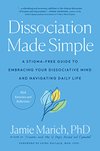Dissociation Made Simple: A Stigma-Free Guide to Embracing Your Dissociative Mind and Navigating Daily Life
amazon.com
Saved by Daph and
Dissociation Made Simple: A Stigma-Free Guide to Embracing Your Dissociative Mind and Navigating Daily Life

Saved by Daph and
The twenty-seven participants who spoke about the role of expressive arts in their healing process did so with great enthusiasm. Some of the specific practices named include: Listening to music Playing or creating music (e.g., drumming, playing the guitar, singing, DJ-ing) Dance and movement Arts and crafts Doodling Meme-making Sand-tray work
... See moreIf you already know that you are working with a system, or different aspects of yourself, perhaps note which skills are best and most effective for certain parts of you.
Many of our contributors noted this sense of complete safety with their guide through healing as imperative, even if they didn’t experience total safety in other places in the world. Other contributors noticed that even if they have moments of feeling unsafe with a therapist, which sometimes happens on bad days or if they are transitioning into a
... See moreThe general definition that I teach for grounding in my clinical courses is a combination of spiritual director Martha Postlewaite’s work on grounding2 with some of my own flair added in. Grounding is using any and all available senses and experiences to remain in the present moment, or to return to the present moment.
One of the reasons we encourage people who dissociate to learn grounding skills is so they can cultivate a sense of safety within themselves. Creating a safe harbor within can be essential when navigating a world that fundamentally feels unsafe.
In various forms of functional brain scans, the areas that show up as most active in terms of dissociation are rich in endogenous opioid receptors (found in the limbic system). You can think of our endogenous opioid system as our body’s natural defenses it can muster against pain, yet people often find that taking euphoria-producing medications or
... See moreThe “Safe Enough” Harbor and Other Grounding Exercises Recovery sponsors (mentors) will often say, “Write down a hundred things that make you feel good that do not involve drugs, alcohol, or acting out.” Some examples include the freshness when you pop a mint into your mouth, or the potentially pleasant sensation when taking that first morning
... See moreSeven contributors describe practices that would qualify as withdrawing from excess sensory distraction as important to their overall grounding plan. Getting enough sleep, setting boundaries, and taking a nap all fall into this category.
There are a variety of tasks that we either develop naturally or learn as a way to achieve some degree of separation (e.g., enough to stay somewhat present but still get some relief, or going further into totally cutting oneself off from in-the-moment presence). Dissociation of this nature is not all or nothing—it generally happens in degrees and
... See more